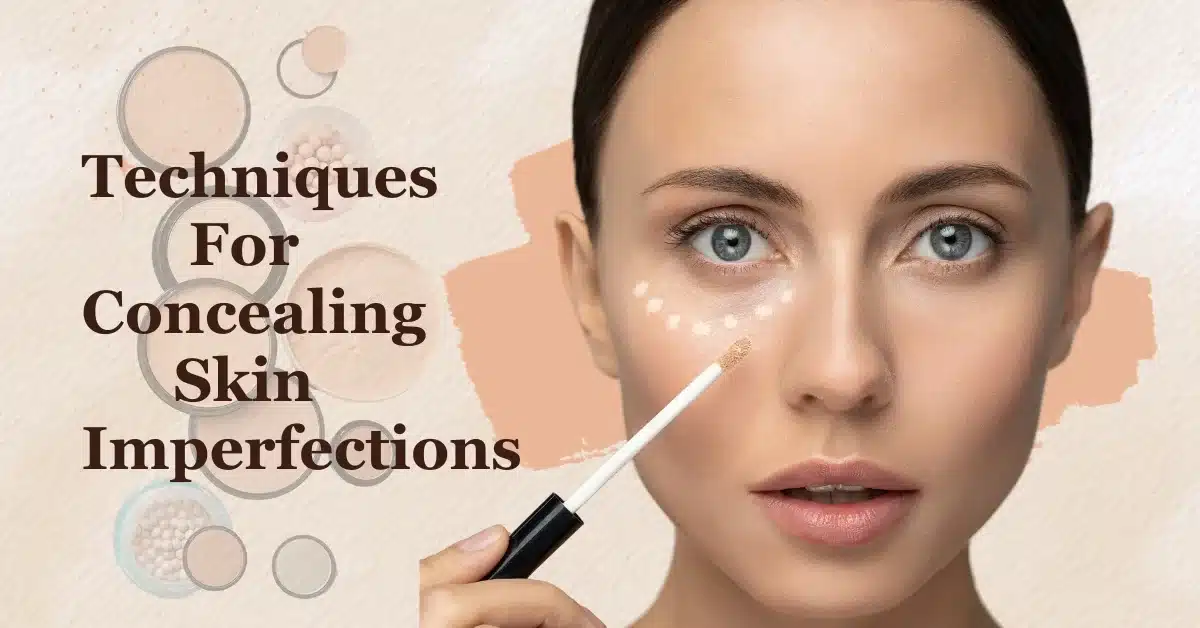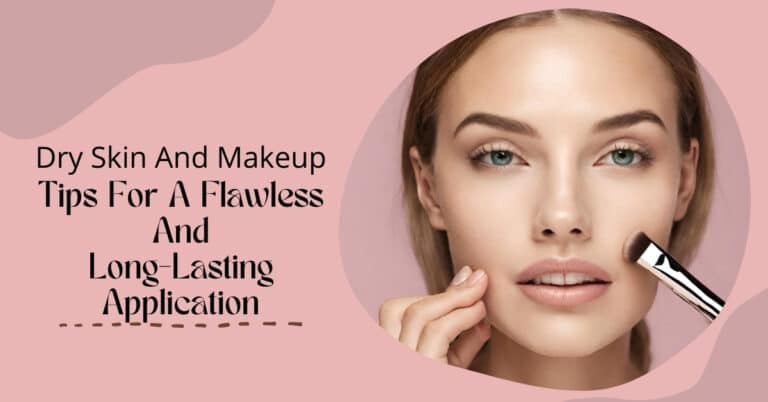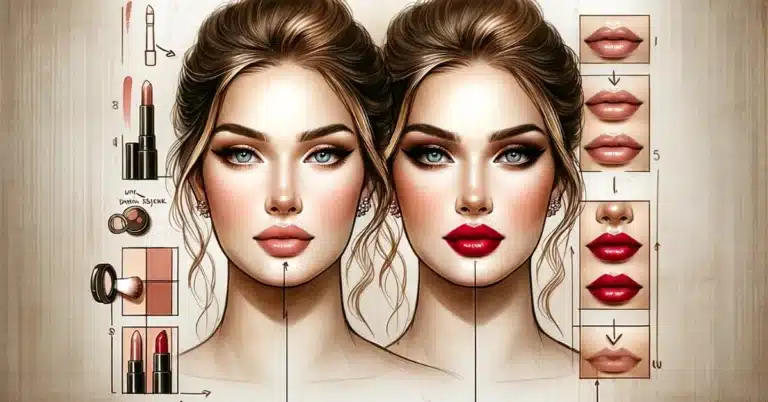Understanding Color Correcting: Techniques For Concealing Skin Imperfections

Isn’t it cool how makeup keeps changing and getting better? Lately, there’s been a big shift that makes makeup more doable for everyone, even if you’re just starting out. They’ve made things easier, and there are new kinds of makeup to try. One of the coolest things is color correctors – those colorful concealers that help hide spots and make your makeup look better!
You might have seen celebs and influencers using all those different colored concealers on their faces. It looks a bit crazy, right? Like, why would you put purple on your face? But, trust me; color correcting is worth a shot, especially if you want a more natural makeup look. Before you give it a go, it’s a good idea to learn a bit about color correctors and how they work. It’s like having a secret weapon in your makeup bag!
Table Of Contents
- What is Color Correcting?
- Choosing the Right Color Corrector for Your Skin Tone
- Step-by-Step Guide to Color Correcting Techniques
- Common Skin Imperfections and Corresponding Color Correction Solutions
- Best Practices for Long-Lasting Color Correction Results
- Expert Insights: Color Correcting for Various Skin Types
- Incorporating Color Correcting into Your Makeup Routine
What is Color Correcting?
Color correcting is a makeup technique that involves using specific colors to neutralize or balance out undesired tones on the skin. The concept is based on the color wheel, where colors opposite each other cancel each other out. In the context of makeup and skincare, color correcting is primarily used to address various skin imperfections such as redness, dark circles, sallowness, and discoloration.
Each color corrector corresponds to a specific issue:
- Green: Neutralizes redness, such as acne scars or rosacea.
- Peach/Orange: Counteracts blue tones, often used to conceal dark circles under the eyes.
- Yellow: Combats purple or blue hues, suitable for concealing bruises or veins.
- Lavender: Counteracts yellow tones, providing a brightening effect on dull or sallow skin.
- Pink: Helps to conceal dark circles and brighten the overall complexion.
The key to effective color correcting is selecting the right shade for the specific issue and applying it before foundation or concealer. The goal is to create a more even skin tone and ensure that the final makeup look appears natural and flawless.
Choosing the Right Color Corrector for Your Skin Tone
Selecting the appropriate color corrector for your skin tone is a pivotal step in achieving effective and natural-looking results. Understanding the principles of the color wheel and how complementary colors neutralize each other is the key to this process.
- Fair or Light Skin Tones: Opt for a light peach or pink corrector to counteract under-eye darkness or dullness.
- Medium Skin Tones: Consider peach or orange correctors to address hyperpigmentation or dark spots on individuals with medium skin tones.
- Olive or Tan Skin Tones: Choose a slightly deeper peach or orange shade for individuals with olive or tan skin tones.
- Deeper Complexions: Explore rich orange or red correctors to effectively counteract dark circles and deep discolorations on deeper complexions.
It’s crucial to experiment and find the correct shade that harmonizes with your skin undertones. Additionally, considering the specific concern, whether its redness, dark circles, or sallowness, will further guide the selection process.
Step-by-Step Guide to Color Correcting Techniques
- Identify specific skin imperfections such as redness, dark circles, or discoloration that you want to address with color correcting.
- Familiarize yourself with the color wheel to know which colors neutralize or counteract different undertones. For example, green neutralizes red, orange counteracts blue or purple, and yellow combats purple or blue hues.
- Choose a color corrector that corresponds to your skin concern. Green correctors work well for redness, peach or orange correctors for dark circles, and lavender for sallow or yellow-toned skin.
- Start with a clean and moisturized face. Applying a primer can help create a smooth base for color correction.
- Use a small amount of color corrector, as a little goes a long way. Dab or swipe the corrector onto the targeted areas using a makeup brush, sponge, or your fingertip.
- Gently blend the color corrector into your skin using tapping or patting motions. Ensure seamless blending to avoid noticeable color patches.
- If the imperfections require more coverage, layer the color corrector with a concealer or foundation that matches your skin tone. Blend the layers carefully for a natural finish.
- Set the color-corrected areas with a translucent setting powder to prevent creasing and ensure long-lasting wear.
- Assess your makeup in natural light to ensure that the color correction appears natural and complements your overall look.
Color correcting is a skill that improves with practice. Experiment with different techniques and products to find what works best for your unique skin concerns and tones.
Common Skin Imperfections and Corresponding Color Correction Solutions
Redness
- Skin Imperfection: Red or irritated areas, often caused by acne, rosacea, or sensitivity.
- Color Correction Solution: Green color corrector neutralizes redness. Apply a small amount to the affected areas before foundation.
Dark Circles
- Skin Imperfection: Shadows or discoloration beneath the eyes.
- Color Correction Solution: Peach or orange correctors counteract blue or purple tones. Dab a small amount on dark circles and blend gently.
Hyperpigmentation
- Skin Imperfection: Dark spots or uneven pigmentation.
- Color Correction Solution: Choose a corrector that matches the undertone of your hyperpigmentation – peach, orange, or yellow may be effective.
Sallowness
- Skin Imperfection: Yellow or dull complexion.
- Color Correction Solution: Lavender corrector helps counteract sallowness and provides a brightening effect. Apply sparingly to areas with a yellow undertone.
Blotchiness
- Skin Imperfection: Uneven skin tone with patches of discoloration.
- Color Correction Solution: Apply a color corrector that matches the specific undertones of the patches – peach, lavender, or green may be used selectively.
Acne Scars
- Skin Imperfection: Residual marks from healed acne.
- Color Correction Solution: Green corrector helps neutralize the redness of acne scars. Apply before foundation for a more even complexion.
Underlying Veins
- Skin Imperfection: Visible veins or blue-toned areas.
- Color Correction Solution: Yellow or peach correctors can help counteract the blue tones of veins. Apply a small amount and blend gently.
Dullness
- Skin Imperfection: Lack of vibrancy, often due to fatigue or dehydration.
- Color Correction Solution: A touch of lavender corrector on areas prone to dullness, like the cheeks or forehead, can provide a subtle brightening effect.
Remember to adapt these color correction solutions based on your unique skin tone and concerns. Experimentation and practice will help you find the most effective combination for achieving a natural and flawless complexion.
Best Practices for Long-Lasting Color Correction Results
- Begin with well-moisturized skin for a smooth canvas.
- Apply a makeup primer to enhance product adherence.
- Invest in high-quality, long-wearing color correctors.
- Use a minimal amount of color corrector to avoid a heavy finish.
- Layer products in thin, buildable layers for even blending.
- Set color-corrected areas with translucent setting powder.
- Refrain from touching to prevent makeup disruption.
- Finish with setting spray for added longevity.
- Adjust routine based on weather conditions (e.g., use oil-free products in humid weather).
- Carry a makeup kit for touch-ups, especially in high-friction areas.
- Assess makeup periodically in natural light for accuracy.
- Use a gentle makeup remover or cleanser during the removal process.
Expert Insights: Color Correcting for Various Skin Types
Expert insights on color correcting for various skin types emphasize the importance of tailoring the approach to individual needs. Different skin types come with unique challenges, and understanding these nuances can help you achieve effective color correction.
For Oily Skin
Experts recommend using lightweight, oil-free color correctors to avoid exacerbating excess oil production. Setting with a mattifying powder can help control shine without compromising the correction.
Keep blotting papers handy to absorb excess oil and maintain a fresh, matte look throughout the day.
For Dry Skin
Moisturizing before color correction is crucial for those with dry skin. Opt for creamy or liquid correctors that won’t accentuate dry patches, and consider using hydrating primers to create a smooth canvas.
For Sensitive Skin
Select hypoallergenic and fragrance-free color correctors to minimize the risk of irritation. Patch testing new products is recommended, and a gentle touch during application helps prevent skin sensitivity.
For Combination Skin
Tailoring the approach to different areas of the face is essential for combination skin. Using a variety of corrector textures, such as creams for dry areas and liquids for oily zones, allows for a balanced correction.
For Mature Skin
Choosing color correctors with hydrating properties is crucial for mature skin. Cream or liquid formulations that won’t settle into fine lines are recommended, and a light hand during application helps avoid emphasizing wrinkles.
Also check out these makeup tips for mature skin – a light touch with a luminous blush that apparently adds a youthful glow.
For Acne-Prone Skin
Opt for non-comedogenic, oil-free correctors for acne-prone skin. Green correctors can help neutralize redness from acne, but a gentle touch is vital to avoid aggravating existing breakouts.
For Fair or Dark Skin Tones
Consideration of skin undertones is emphasized for individuals with fair or dark skin tones. Experts recommend selecting color correctors that complement the specific undertones to achieve seamless correction.
For Rosacea-Prone Skin
Individuals with rosacea should be cautious with green correctors, as they can sometimes be too intense. Using a color corrector with a yellow undertone may be a gentler option for neutralizing redness.
General Tips
Consistent skin care routines, including proper cleansing and moisturizing, are crucial for all skin types. Additionally, experts highlight the significance of regularly reassessing color correction needs, as skin conditions can change over time.
Incorporating Color Correcting into Your Makeup Routine
Incorporating color correcting into your makeup routine is a strategic and transformative step that can significantly enhance the overall finish of your look.
Begin by identifying specific skin concerns, such as redness, dark circles, or discoloration, that you wish to address. Once pinpointed, choose the appropriate color corrector based on the principles of color theory.
Integrate color correction after your skincare routine and before applying foundation or concealer. Start with a small amount of product, gradually build up if needed, and blend meticulously to achieve a seamless transition between corrected and natural skin. Tailor the application to your unique skin type and tone, keeping in mind the specific needs of oily, dry, sensitive, or combination skin.
Remember to set the corrected areas with a light touch of translucent powder to ensure longevity and prevent creasing.
Color correcting is a skill that improves with practice. Experiment with different techniques and products to find what works best for your unique skin concerns and tones.
By incorporating color correcting into your makeup routine in a thoughtful and targeted manner, you can effectively address specific skin concerns and achieve a polished, flawless finish.
FAQs
Q: What is color correcting, and how does it work?
A: Color correcting is a makeup technique that involves using specific colored concealers to neutralize or balance out skin imperfections. It works on the principle of complementary colors, where opposite hues on the color wheel cancel each other out. For example, green corrects redness, while peach or orange neutralizes dark circles.
Q: How do I choose the right color corrector for my skin tone?
A: Consider your specific skin concerns and choose a color corrector that corresponds to those concerns. For example, green correctors work for redness, peach or orange for dark circles, and lavender for sallowness. Additionally, take into account your skin tone and undertones when selecting the corrector shade.
Q: Can I skip color correction and just use concealer?
A: While concealer can provide coverage, color correction is specifically designed to address underlying tones like redness or discoloration. Depending on your skin concerns, incorporating color correction into your routine can enhance the effectiveness of concealer and result in a more flawless finish.
Q: How do I prevent color correction from looking too heavy or cakey?
A: Apply color correctors sparingly, using a minimal amount and building up if necessary. Blend thoroughly to avoid demarcation lines, and set with a small amount of translucent powder. Additionally, layering thin, buildable layers of corrector and subsequent makeup products helps prevent a heavy appearance.
Q: Can I use color correction for acne-prone skin?
A: Yes, but it’s important to choose non-comedogenic, oil-free correctors and be gentle during application to avoid aggravating existing breakouts. Green correctors can be effective in neutralizing redness associated with acne.
Q: How long does color correction last, and how can I make it last longer?
A: The longevity of color correction depends on factors such as product quality, application technique, and environmental conditions. To make it last longer, start with a well-prepped canvas, use primer, choose long-wearing products, set with powder, and consider weather conditions when applying makeup.
Q: Can color correction be used on mature skin?
A: Yes, color correction can be used on mature skin. Opt for creamy or liquid formulations that won’t settle into fine lines, and choose hydrating products to maintain a natural and youthful appearance.
Q: Is it necessary to color correctly every day?
A: It depends on your individual skin concerns. While not necessary for everyone, color correction can be beneficial for addressing specific issues. Some may choose to incorporate it into their daily routine, while others reserve it for special occasions or when specific concerns arise.
References
https://www.sheldonbruckmua.com/post/color-theory-correcting-concealing
https://www.maybelline.co.in/makeup-tips/face-makeup/colour-correcting-for-beginners
https://www.bebeautiful.in/all-things-makeup/face/how-to-pick-and-use-the-right-colour-correctors





